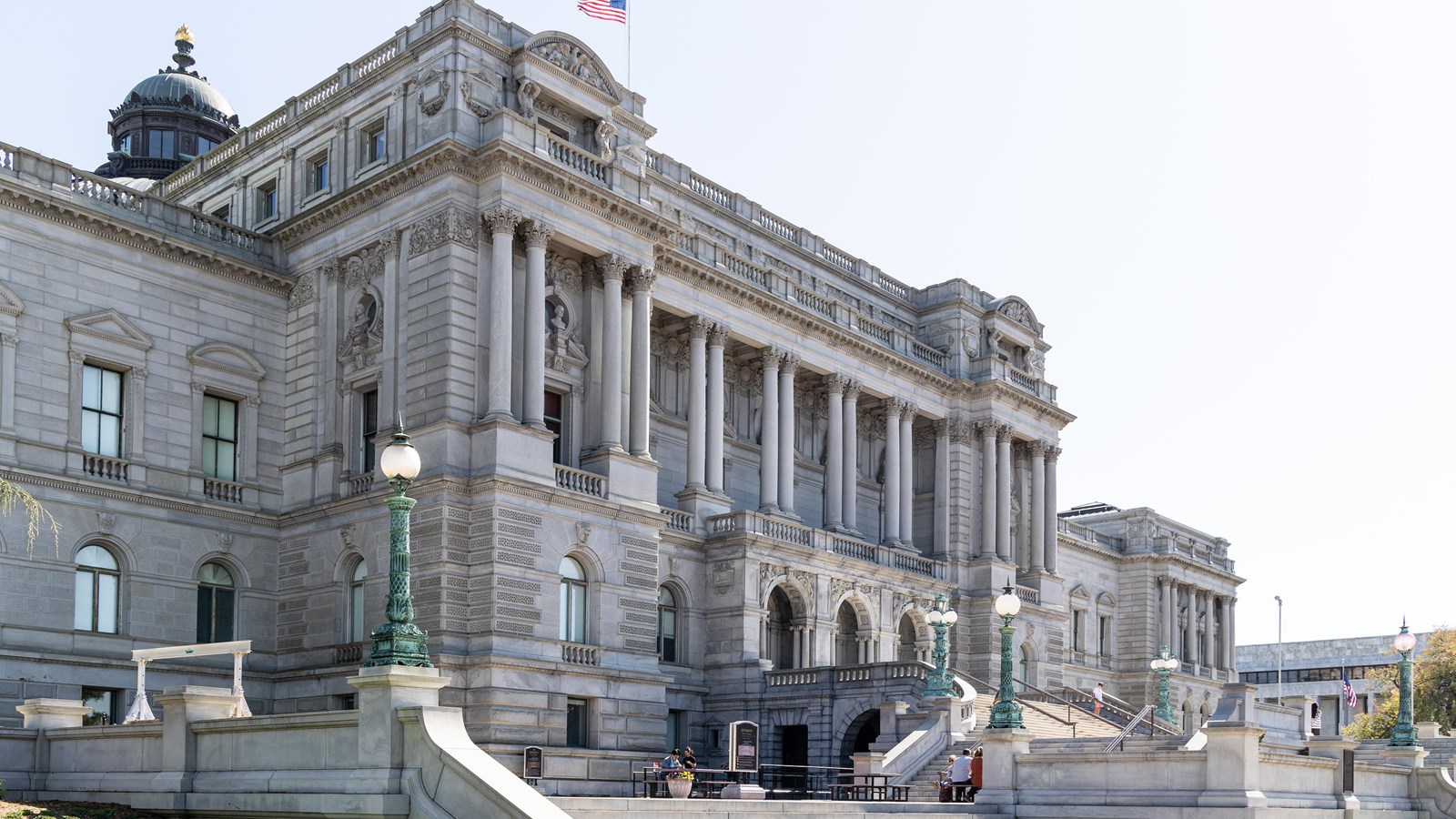Last updated: July 10, 2024
Place
The Library of Congress

Billy Wilson, Flickr, 2022.
The Library of Congress is located on Capitol Hill in Washington, DC. Originally established in 1800, the library was an essential resource for members of Congress but did not have its own dedicated building until 1897 when architects Smithmeyer and Pelz designed this magnificent Beaux Arts-inspired building.1 The Library of Congress holds one of the largest collections in the world and embodies the importance placed on access to knowledge in the nation. The Library of Congress was designated a National Historic Landmark in 1975 based on its significant contributions to American culture through architecture, education, politics and government.2
Reading the Room: A Need for More Space
For almost a century after it was established the books and materials of the Library of Congress were housed in the US Capitol building. By 1881 the collection had outgrown its space at the Capitol, prompting Congress to fund the design and construction of an independent building. The design of the library building is an exceptional example of Beaux Arts design. Completed in 1897, it became a monument to the preservation and pursuit of knowledge.3
Between 1801 and 1897 the library collected books, maps, atlases, public documents, newspapers, and society publications. During its early years, the largest single acquisition was the purchase of Thomas Jefferson’s 6,457-volume personal library in 1815. Jefferson sold his collection in response to the library’s collection being severely damaged after the British burned the US Capitol during the War of 1812.4 Following this acquisition, the library’s collection steadily grew and continued to include a wide breadth of subjects and materials.
Initially, the library and its collections were meant only for members of Congress. Following the Civil War however, Librarian of Congress Ainsworth Rand Spofford successfully advocated for the use of the library collections by both Congress and the American people. By 1902 Congress authorized the sale and distribution of the Library’s printed catalog cards to other libraries, signaling the beginning of the Library’s role as a national resource.5 At the turn of the twentieth century, the Library of Congress emerged as an institution dedicated to public knowledge and education.
Checking-out the Internet
In 2022, the Library of Congress collection included over 175 million items and was claimed to be the largest library in the world.6 These materials are preserved so they can be used and studied by members of Congress and the public. In over a century of operation, the Library of Congress has championed both preserving knowledge and providing access to resources for both libraries and individuals around the world.
As the library entered the information age, it initiated the National Digital Library project in 1994 to provide digital access to its collections.7 The project succeeded in modernizing library functions and increasing public access to the library’s collections. Today the library is an essential resource for research that defines standards for in-person and digital use, as well as the curation of library collections nationwide.
The worldwide reach of the Library of Congress continues to be seen and felt today. Thanks to the availability of digital collections, and the library’s physical manifestation in the 1897 building, the institution is truly “a monument to American achievement and ambition.”8
In 1975, the Library of Congress became a National Historic Landmark based on its significant contributions to American history and culture through architecture, education, politics and government.
Notes:
[1] “Washington, DC NHL Library of Congress,” National Register of Historic Places Inventory Form, (1965): 2. https://catalog.archives.gov/id/117691837.
[2] These categories (among others) are provided by the National Register of Historic Places on the NHL nomination form to help describe the national significance of a place. Relevant categories are selected by the nominator and are supported by historical evidence in the submission.
[3] “Washington, DC NHL Library of Congress,” National Register of Historic Places Inventory Form, (1965): 3. https://catalog.archives.gov/id/117691837.
[4] James H. Billington, “Libraries, the Library of Congress, and the Information Age” Daedalus 125, no. 4 (1996): 41.
[5] Billington, “Libraries,” 42-3.
[6] Library of Congress, “About the Library: General Information,” Library of Congress, Accessed November 27, 2023.
[7] Billington, “Libraries,” 47.
[8] Library of Congress, “History of the Library of Congress,” paragraph 10. https://www.loc.gov/about/history-of-the-library.
Sources:
Billington, James H. “Libraries, the Library of Congress, and the Information Age.” Daedalus 125, no. 4 (1996): 35-54.
Library of Congress. “About the Library: General Information.” Library of Congress. Accessed, November 27, 2023. https://www.loc.gov/about/general-information/.
National Historic Landmark Nomination Form
National Historic Landmarks (NHLs) are historic places that possess exceptional value in commemorating or illustrating the history of the United States. The National Park Service’s National Historic Landmarks Program oversees the designation of such sites. There are over 2,600 National Historic Landmarks in the US and its territories. All NHLs are also listed in the National Register of Historic Places.
